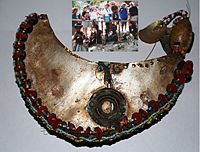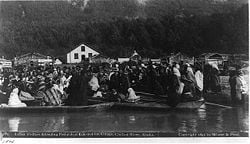Gift economy
Man presents a cut of meat to a youth with a hoop. Athenian red-figure vase, ca. 460 B.C.E.
Gift exchange is a type of long-standing and cross-cultural human tradition involving the giving of money, goods, etc., without the direct compensation that is involved in trade, although possibly involving a social expectation of reciprocity, or a return in the form of prestige or power. In many human societies, the act of mutually exchanging gifts contributes to social cohesion. Economists have elaborated the economics of gift-giving into the notion of a gift economy.
Nature of Gifts
The word gift most commonly refers to "the action of giving, an instance of the same; a giving, bestowal"[1]. In contemporary times, gifts are often thought of as tangible goods that are either purchased for the sole purpose of being given as a gift, or goods that are created for the express purpose of gift exchange, such as the armbands and necklaces in the Trobriand Islands' Kula exchange. Often times there are specific occasions for giving gifts, such as a holiday, birthday or other forms of celebration. Other times, the simple act of giving is occasion enough. Beyond the giving of tangible goods, a gift has many different historical connotations.
A gift can refer to anything that makes the other more happy or less sad, especially as a favor, including forgiveness, and kindness (even when the other is not kind).
A gift can also be a special talent or ability that was not earned through the usual amount of long and difficult practice but instead comes easily to the recipient in a natural way. A person with such a gift is said to be "a natural" or "gifted" in that field of endeavor. A gift, in this sense, can be thought of as being given by God or by nature: a God-given or natural gift received by one at birth. For example, a fluent and entertaining speaker is said to have "the gift of gab." Ritual sacrifices can be seen as return gifts to a deity. Sacrifice can also be seen as a gift from a deity: Christianity considers the Incarnation and subsequent death of Jesus to be a "gift" to humankind, and the Jākata contains a tale of the Buddha in his incarnation as the Wise Hare giving the ultimate alms by offering himself up as a meal for Sakka.[2].
The intent behind the gift giving is also significant when looking at individual traditions. While many people consider the essence of a gift to be a self-less act, historically gifts have not always been given with such innocence. Gifts have often been used as bribes, as a way to placate a difficult situation, or are given more out of a sense of obligation than from a desire to help someone or make them happy. With the increase of materialism in today's world, gifts are often evaluated based upon their material value; the more expensive the gift, the better. Certain traditions, such as Christmas, have taken on a wide-spread commercialization, often times driven by retailers who make their largest profits during these times.
Presentation
When material objects are given as gifts, in many cultures they are traditionally packaged in some manner. For example, in Western culture, gifts are often wrapped in wrapping paper and accompanied by a gift note which may note the occasion, the giftee's name, and the giver's name. In Chinese culture, red wrapping connotes luck.
Legal aspects of gifts
In common law, for a gift to have legal effect, it was required that there be (1) intent by the donor to give a gift, (2) acceptance of the gift by the donee, and (3) delivery to the donee of the item to be given as a gift.[3]
In the United States and some other countries, certain types of gifts above a certain monetary amount are subject to taxation. See gift tax for more information.
Gift economy
A gift economy is an economic system in which goods and services are given without any explicit agreement for immediate or future quid pro quo. Typically, a gift economy occurs in a culture or subculture that emphasizes social or intangible rewards for generosity: karma, honor, loyalty or other forms of gratitude. In some cases, simultaneous or recurring giving serves to circulate and redistribute valuables within a community. This can be considered a form of reciprocal altruism. Sometimes there is an implicit expectation of the return of comparable goods or services, political support, or the gift being later passed on to a third party. However, in what is considered to be in the true spirit of gift economics, many times giving is done without any expectation of reciprocity.
The concept of a gift economy stands in contrast to a planned economy or a market or barter economy. In a planned economy, goods and services are distributed by explicit command and control rather than informal custom; in barter or market economies, an explicit quid pro quo — an exchange of money or some other commodity — is established before the transaction takes place. In practice, most human societies blend elements of all of these, in varying degrees.
Some examples of a gift economy in action inlude:
- Sharing of food in a hunter-gatherer society, where sharing is a safeguard against failure of any individual's daily foraging.
- The Pacific Northwest Native American potlatch ritual, where leaders give away large amounts of goods to their followers, strengthening group relations. By sacrificing accumulated wealth, a leader gained a position of honor.
- Southeast Asia Theravada Buddhist Feasts of Merit, similar to the potlatch except that such feasts involve many sponsors of all types, and continue to this day mainly before and after Rainy Seasons rather than chiefly in winter.[4]
- Offerings to a deity, spirit, intercessionary saint or similar entities.
- A political machine, in which a politician gives patronage and favors in expectation of future political support and/or as a reward for past support.
- A "favor network" within a company.
- A family, in which each generation pays for the education of the next: this is an example where the gift creates an implicit obligation to give a gift to a third party, rather than to the giver.
- Religious tithing.
- Charitable giving or philanthropy.
- Open source computer software development.
A gift economy is sometimes referred to as a "sharing economy," although many economists reserve the term "sharing" for the use of a single resource by more than one consumer, such as a common, a public library, or a shared car. It is also sometimes referred to as a "gift culture."
One of the possible benefits of a gift economy (which it has in common with some planned economies) is that it can provide for the needs of some who have no current means with which to reciprocate. For example, if some in a society are so poor as to have nothing material to barter and no goods or money to bring to market, they can still receive charity if sufficient resources exist. Similarly, in the vast majority of societies, parents support their children at least in early childhood (and, in some societies, into adolescence and adulthood) without any explicit negotiation of what is expected in exchange.
Examples of gift exchange systems
Kula
Kula, also known as the Kula exchange or Kula ring, is a ceremonial exchange system conducted in the Milne Bay Province of Papua New Guinea. It involves a complex system of visits and exchanges and was first described in the west by anthropologist Bronislaw Malinowski in 1922. The Kula gifts are of two types and are not in themselves remarkably valuable. One consists of shell-disc necklaces (veigun or Soulava) that are traded to the north (circling the ring in clockwise direction) and the other are shell armbands (Mwali) that are traded in the southern direction (circling counter-clockwise). Mwali was given with the right hand, the Soulava given with the left hand, first between villages then from island to island. If the opening gift was an armband, then the closing gift must be a necklace and vice versa. These are traded purely for purposes of enhancing mutual trust relationships, securing trade, and enhancing one's social status and prestige.
Koha
Koha is a New Zealand Māori custom which can be translated as gift, donation, or remuneration. It is an example of reciprocity which is a common feature of much Māori tradition, and often involves the giving of gifts by visitors to a host marae. Traditionally this has often taken the form of food although taonga (treasured possessions) are also sometimes offered as koha.[5]
In modern times money is most commonly given to offset the costs of hosting a hui (Māori assembly). For the benefit of non-Māori unfamiliar with the custom some marae may suggest a particular amount to be given as koha although this amount may not meet the actual costs associated with the meeting.[6]
In wider current New Zealand society the term has a broader meaning more closely associated with the English term donation. When you are invited to a "free" event you may be asked for 'koha', usually in the form of a "gold coin donation" (i.e., $1 or $2 - this being the color of these coins - rather than smaller silver coin denominations).[7] It is becoming more frequent to refer in English language to the small gifts, or more commonly food such as; biscuits, deserts or cakes, which are presented when visiting friends or family as 'koha'. This is a common custom amongst New Zealanders, especially so in rural areas. This custom, if not rooted in the Māori custom (tikanga), has been reinforced by it.
Sepik Coast Exchange
Sepik Coast exchange is the method of social networking and alliance in the Sepik Coast area of Papua New Guinea.
Families living along the Sepik Coast in northern Papua New Guinea form alliances with families in other communities. Depending on the importance and status of the family, it can have anywhere between 5 and 75 contacts in its social network. In each surrounding town, the family knows another. When they travel to another town, they bring gifts to their contact family, and that family will house and care for them. Gifts are reciprocated when given or later when families return the visit. Common gifts are sago, tobacco, baskets, wooden bowls, and other similar items. The recipient does not specify which type of gift they would like to receive, but as a result of the vast quantity of exchanges taking place, the needs of participants are generally met.[8]
A social field is one in which all the members have similar expectations of each other. In the social networks of the Sepik Coast, the significant expectations are hospitality, gift giving and reciprocation from friends in different villages. Alliances are passed along and preserved through many generations, because fathers bring their sons on their trips and families honor an association, no matter how long it has been since the last gift exchange.
Moka
The Moka is a system of exchange in the Mt. Hagen area, Papua New Guinea. It is a complex system of exchange that relies heavily on pigs as currency for status in the community.
The Moka is the vehicle by which big-men obtain their status and is a complicated game of zero-sum exchanges of material culture that serves to elevate prestige. A big-man can have several Moka partners with whom he carries on exchanges: some on a larger scale than others. He must be constantly thinking about people he owes and people who owe him, the timing of the next Moka, and how he might subtly undermine another big-man to gain more prestige.
The Moka encompasses a large area around Mt. Hagen and involves large-scale exchanges of pigs between big-men. Moka is based on competition between big-men; at any given time in the process, there is inequality between the players. Big-men are able to exchange huge numbers of pigs at the Moka by having a large support group of men who have received small gifts of sweet potatoes or pigs in exchange for one or two pigs. The pigs accumulate from many sources and when there are enough, they are given to a rival big-man. That big-man uses them to repay what he owes to his supporters (in addition to using many of them as a feast at the Moka) and has a few years to breed and amass pigs enough to equal and outdo the previous gift. In this fashion the exchange is continued, each exceeding the other in turn. He could also use the gift to make Moka to a third big-man, guaranteeing superiority over him for a time.[9]
The Moka depends on the big-man, who is dependent upon his social network of supporters. The Moka continues until one of the big-men cannot reciprocate and increase the gift and his inferiority to the other is established. Theoretically, Moka exchanges continue for an indefinite amount of time and an outcome is never reached. At any time, one of the more important members of a big-man’s social network may decide that he is better off supporting a rival big-man and could switch sides, so to speak, and undermine his former big-man while strengthening his rival. There is always uncertainty involved in the Moka.[10]
Potlatch
The ceremonial feast called a potlatch, practiced among a diverse group of Northwestern Native Americans as an integral part of indigenous culture, had numerous social implications. The Kwakiutl, of the Canadian Pacific Northwest, are the main group that still practices the potlatch custom. Although there were variants in the external form of the ceremony as conducted by each tribe, the general form was that of a feast in which gifts were distributed. The size of the gathering reflected the social status of the host, and the nature of the gifts given depended on the status of the recipients. Potlatches were generally held to commemorate significant events in the life of the host, such as marriage, birth of a child, death, or the assumption of a new social position. Potlatches could also be conducted for apparently trivial reasons, because the true reason was to validate the host's social status.
Footnotes
- ↑ "Oxford English Dictionary" (Oxford 1971) ISBN 019861117X
- ↑ Hyde, Lewis "The Gift: Imagination and the Erotic Life of Property" (Vintage 1983) ISBN 0-394-71519-5
- ↑ "Gifts" within the Meaning of the Income Tax Laws (Es Sultaneh v. Comm'r of Internal Revenue, C. C. A. 2d 1947) Columbia Law Review, Vol. 47, No. 6 (Sep., 1947), pp. 1073-1075 Reprinted on JSTOR [[1]]
- ↑ Kammerer and Nicola Tannenbaum, Cornelia Ann (1996). MERIT AND BLESSING: In Mainland Southeast Asian Comparative Perspective.. New Haven (Connecticut): Yale University.: Southeast Asia Studies (Monograph 45).. ISBN ISBN 0-93869261-5.
- ↑ (2007) Tourism New Zealand ["Koha ~ Gift"] Retrieved September 29, 2007
- ↑ (2007) Tourism New Zealand ["Koha ~ Gift"] Retrieved September 29, 2007
- ↑ (2007) Tourism New Zealand ["Koha ~ Gift"] Retrieved September 29, 2007
- ↑ Connell, John "Papua New Guinea: The Struggle for Development"(Routledge 1997), ISBN 041505401X
- ↑ Strathern, Andrew and Marilyn. "Self-Decoration in Mount Hagen" (Gerald Duckworth and Company Ltd 1971) ISBN 071560516X
- ↑ Strathern, Andrew and Marilyn. "Self-Decoration in Mount Hagen" (Gerald Duckworth and Company Ltd 1971) ISBN 071560516X
ReferencesISBN links support NWE through referral fees
- Strathern, Andrew. 1971. The Rope of Moka. Cambridge: Cambridge University Press.
- Welsch, Robert and John Terrell. 1998. "Material Culture, Social Fields, and Social Boundaries on the Sepik Coast of New Guinea." In The Archaeology of Social Boundaries. Miriam Stark, ed. Pp. 50-77. Washington, D.C.: Smithsonian Institution Press.
- Marcel Mauss and W.D. Halls, Gift: The Form and Reason for Exchange in Archaic Societies, W. W. Norton, 2000, trade paperback, ISBN 0-393-32043-X
- "Ongka's Big Moka: The Kawelka of Papua New Guinea" (DVD) 1976, Shanachie
External links
Credits
New World Encyclopedia writers and editors rewrote and completed the Wikipedia article in accordance with New World Encyclopedia standards. This article abides by terms of the Creative Commons CC-by-sa 3.0 License (CC-by-sa), which may be used and disseminated with proper attribution. Credit is due under the terms of this license that can reference both the New World Encyclopedia contributors and the selfless volunteer contributors of the Wikimedia Foundation. To cite this article click here for a list of acceptable citing formats.The history of earlier contributions by wikipedians is accessible to researchers here:
The history of this article since it was imported to New World Encyclopedia:
Note: Some restrictions may apply to use of individual images which are separately licensed.


